
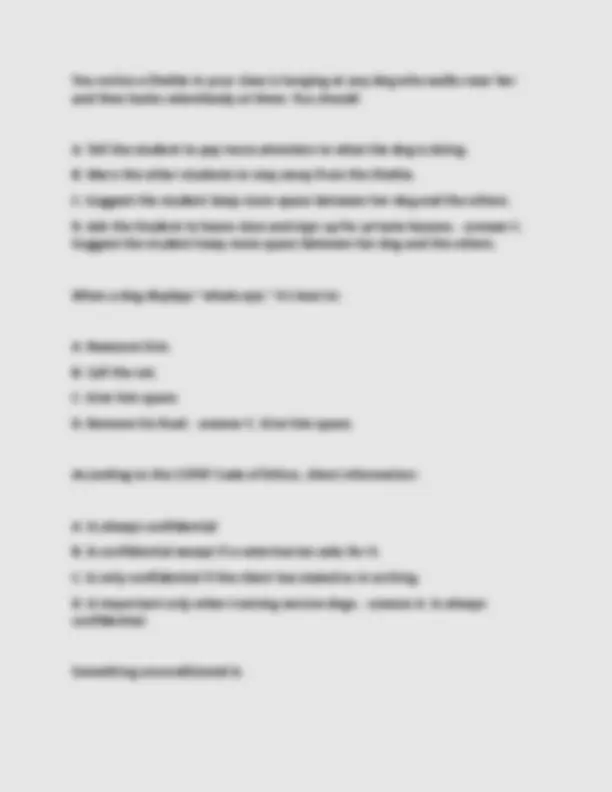
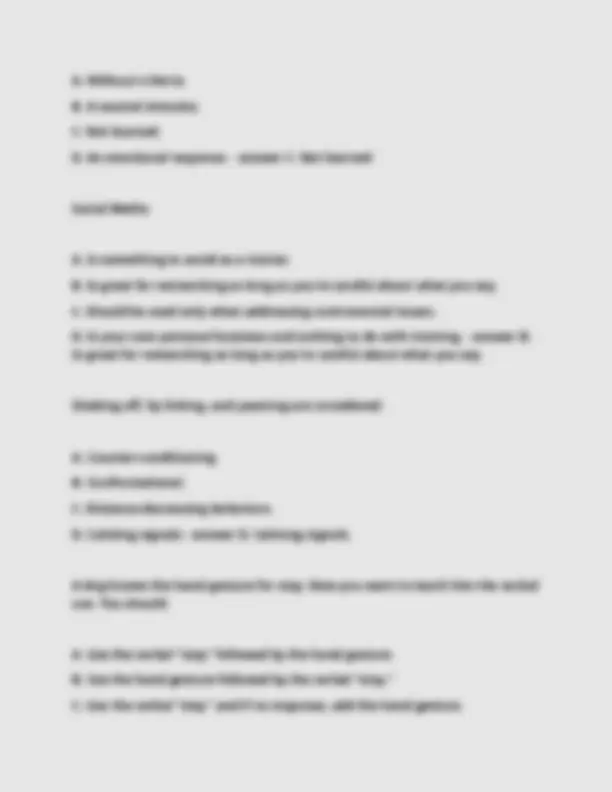
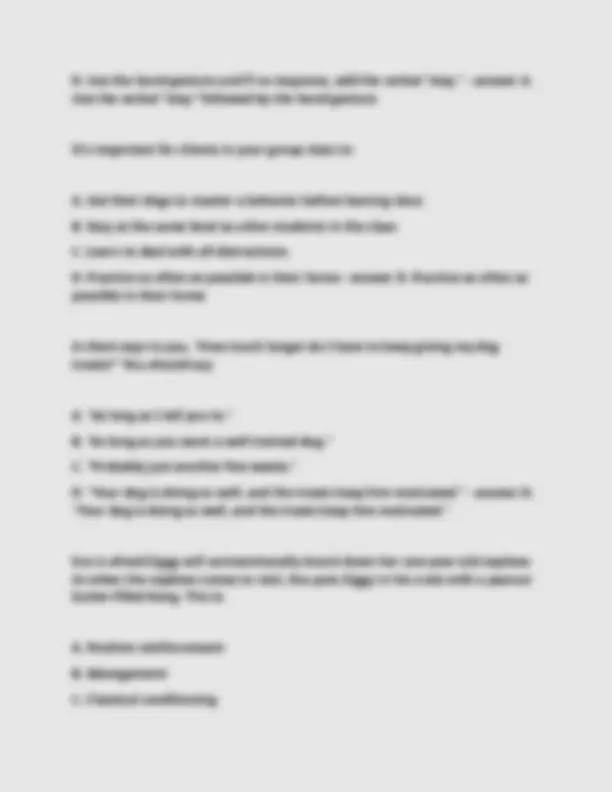
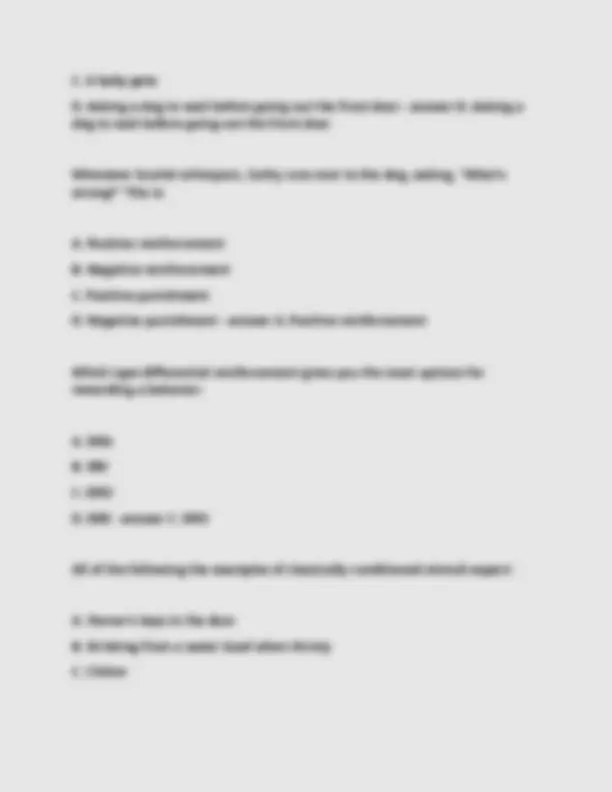
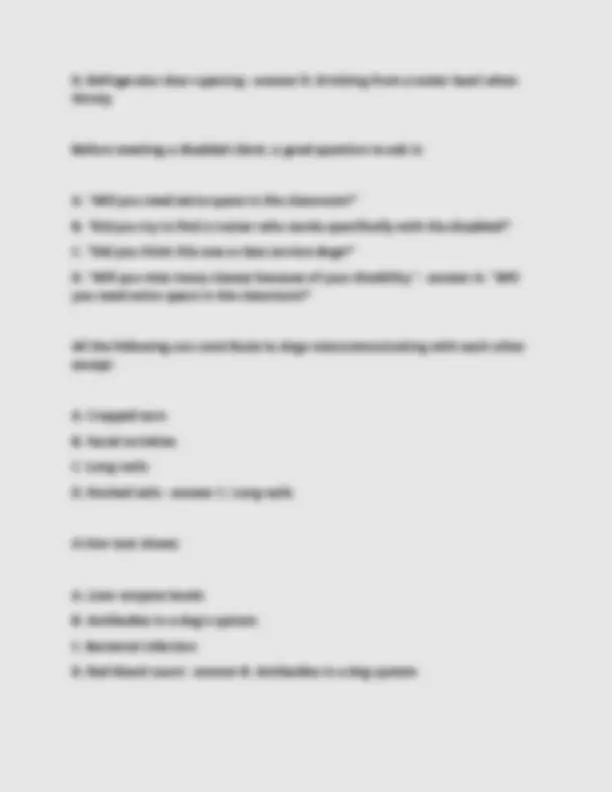
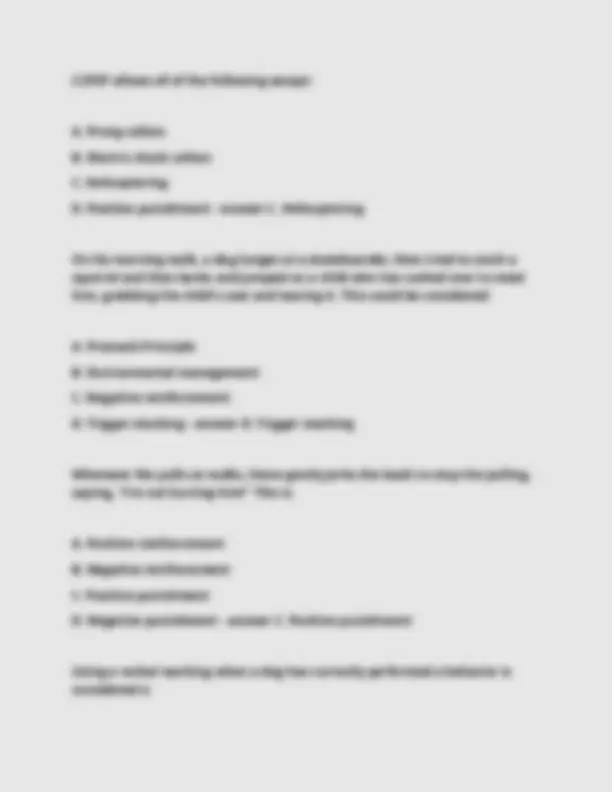
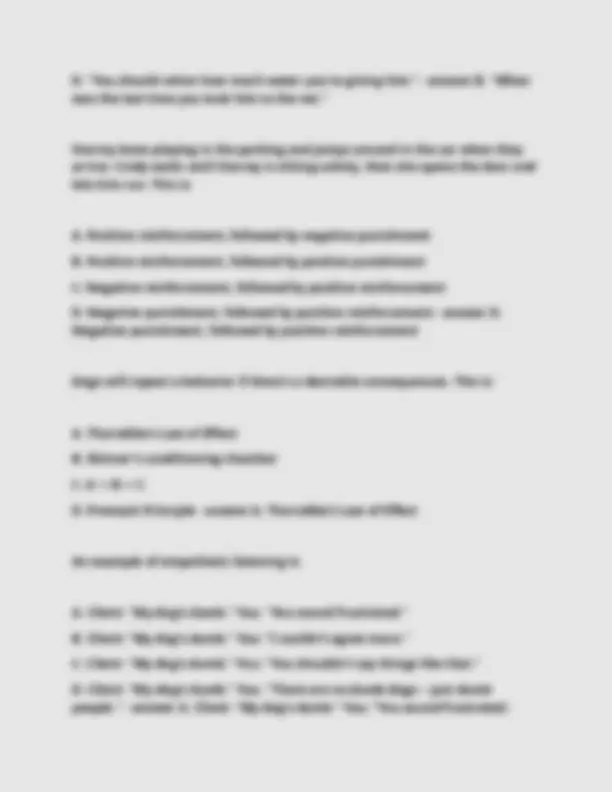
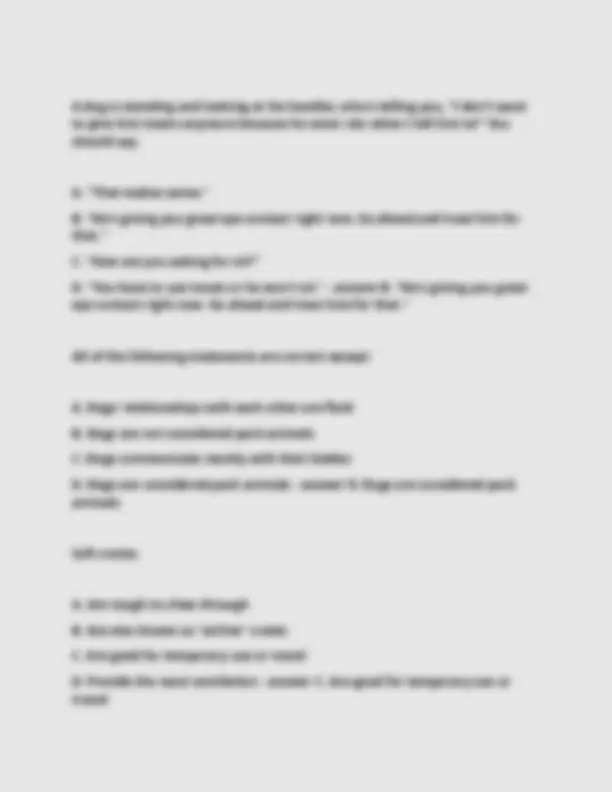
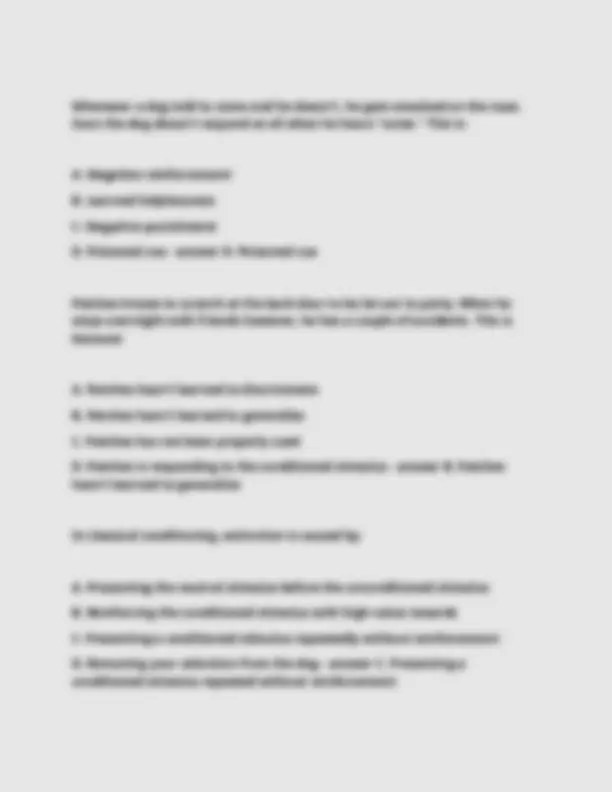
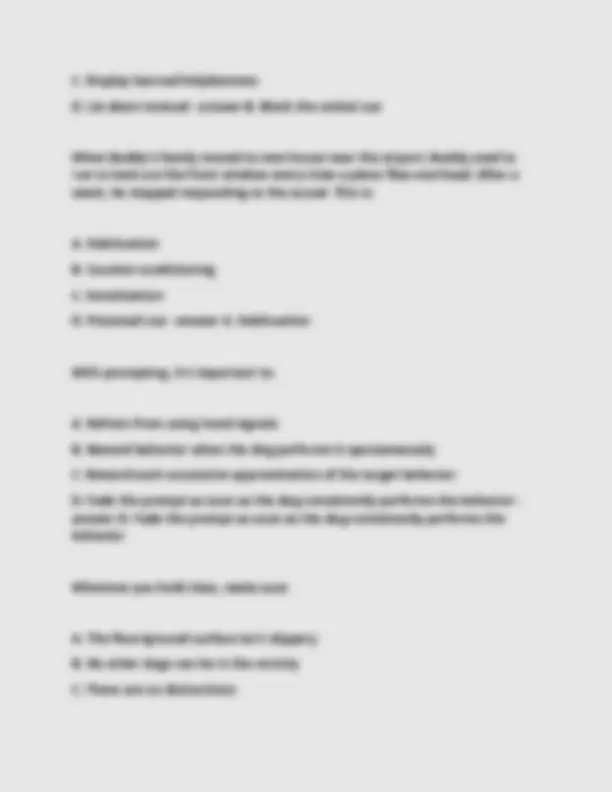
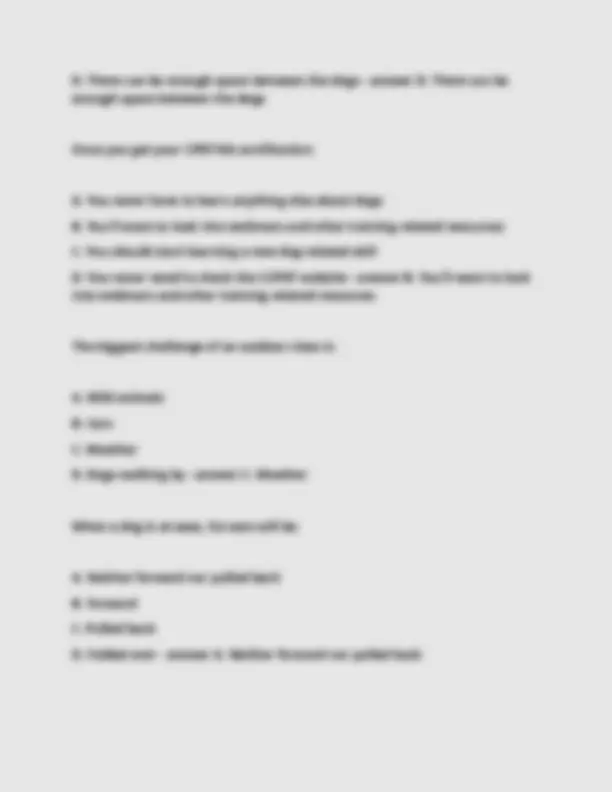
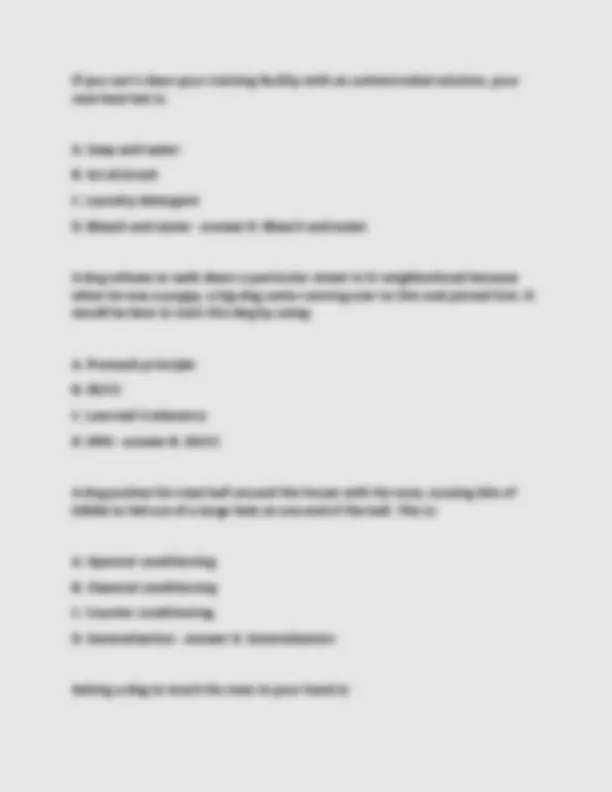
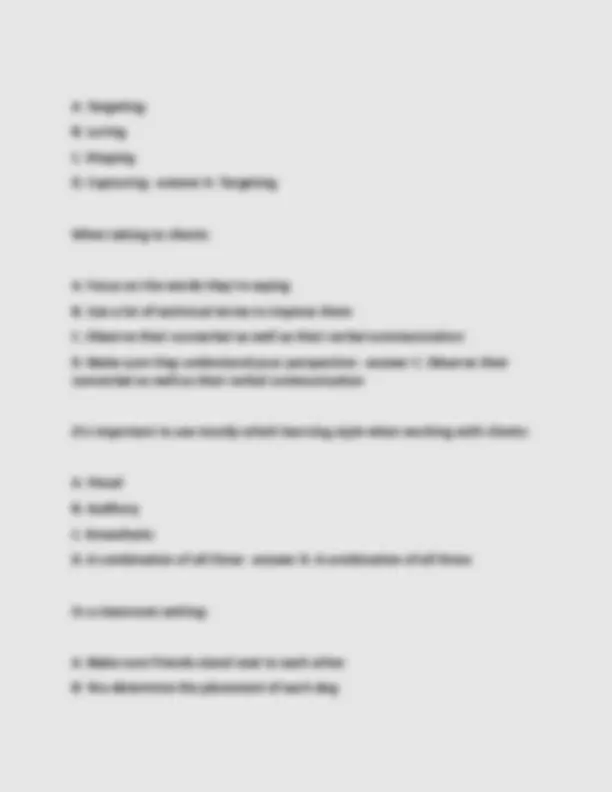
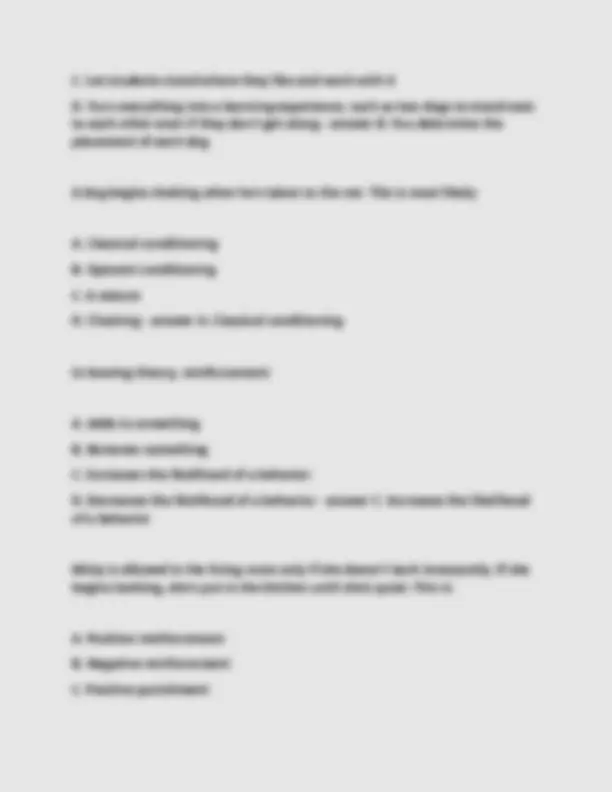
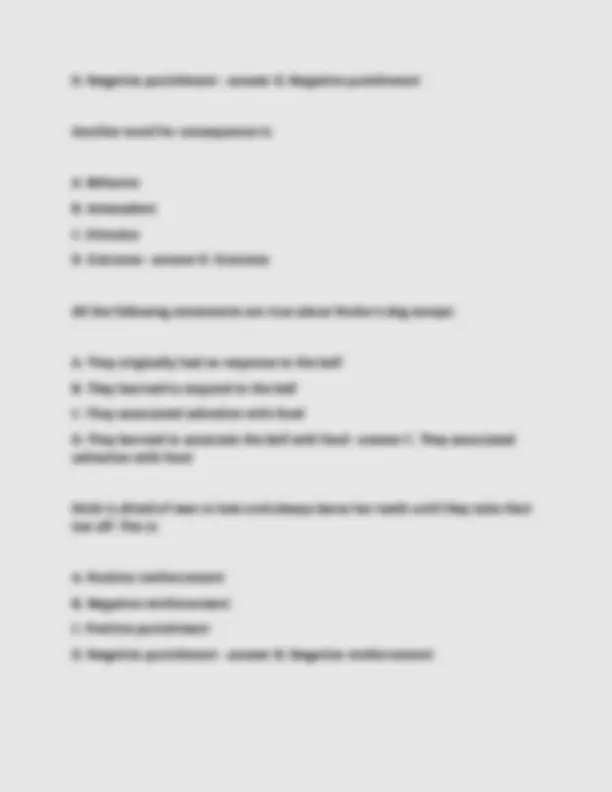
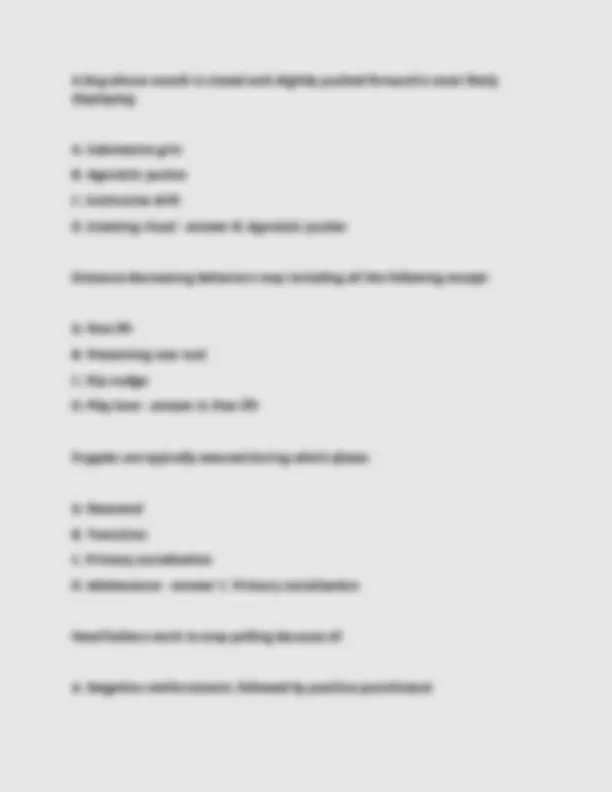
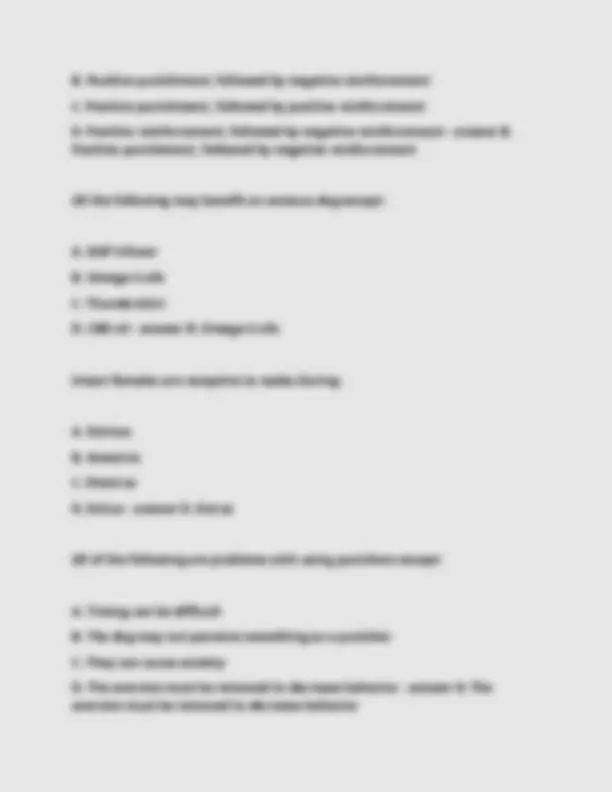
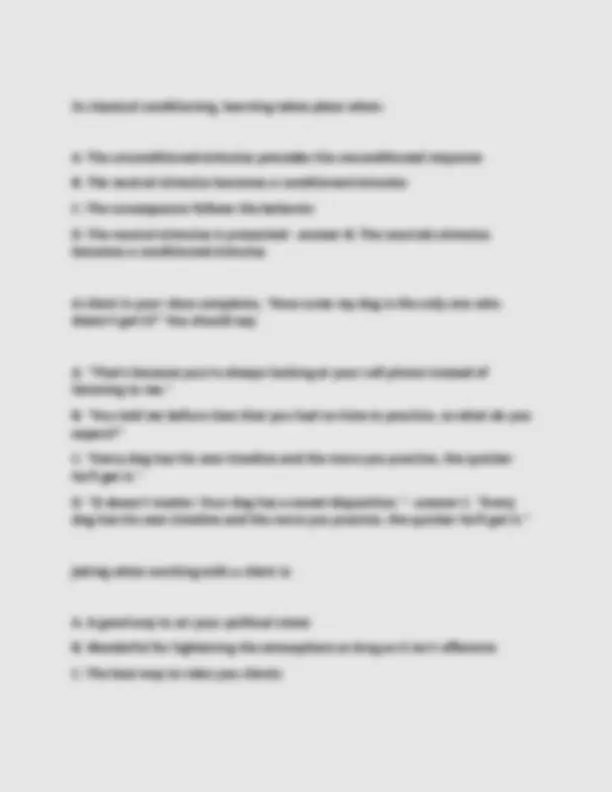
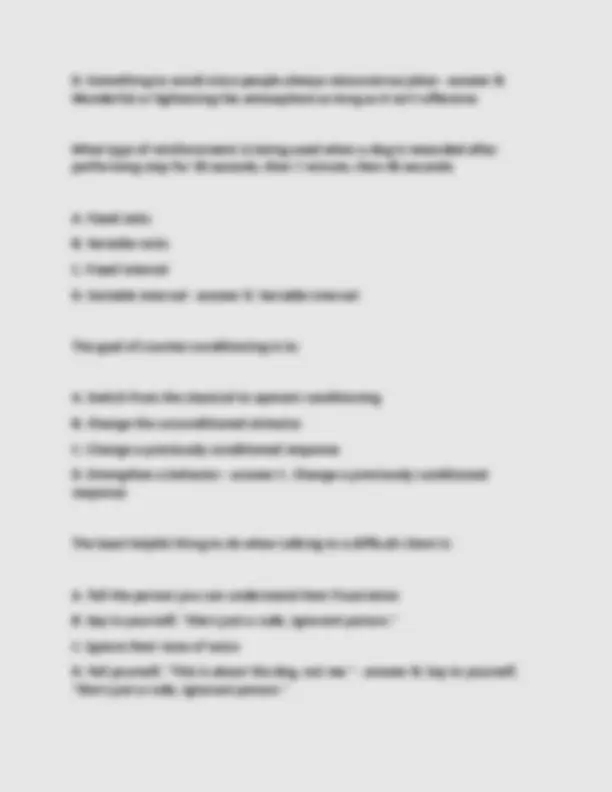
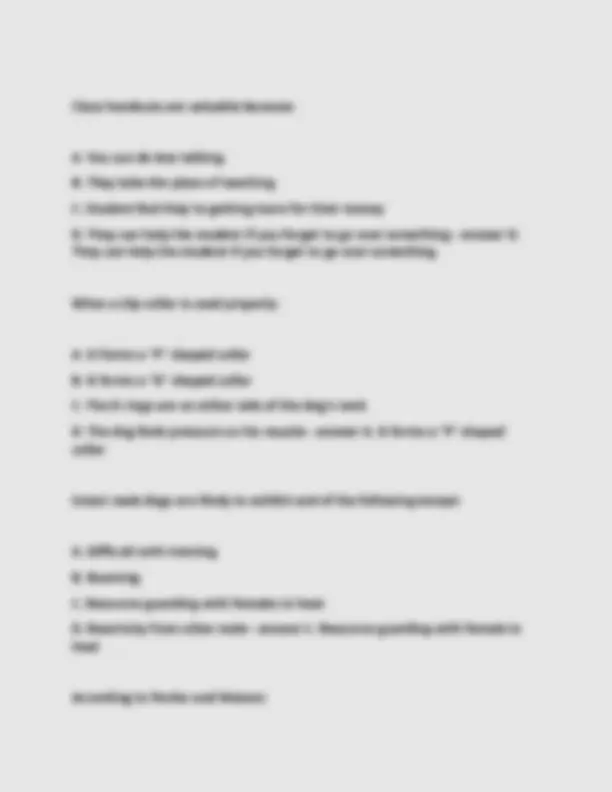
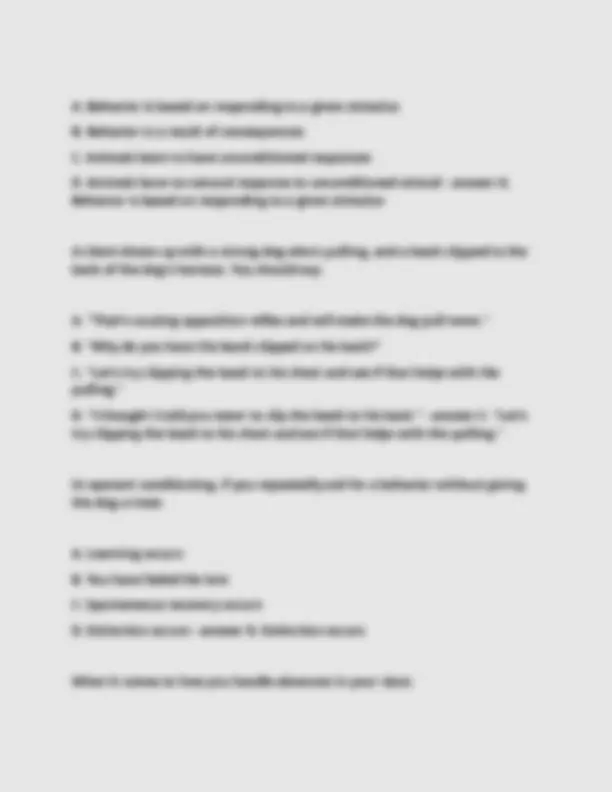
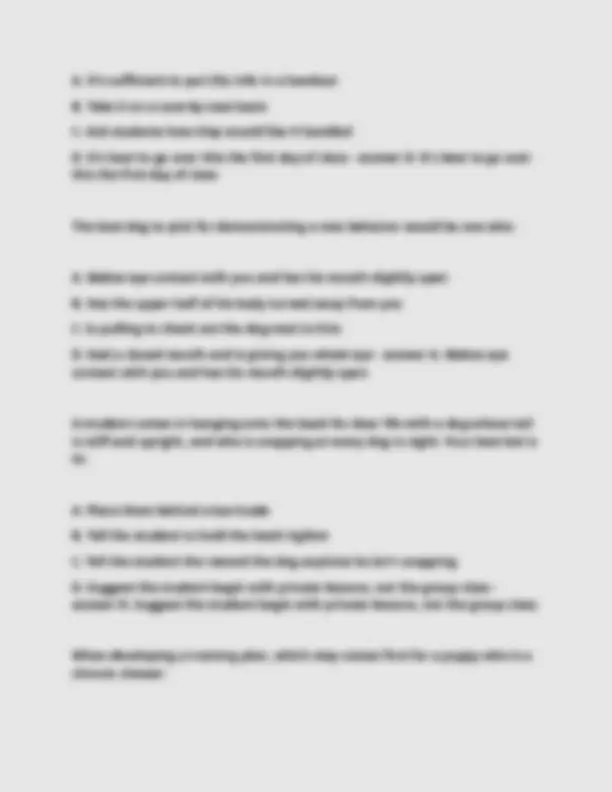
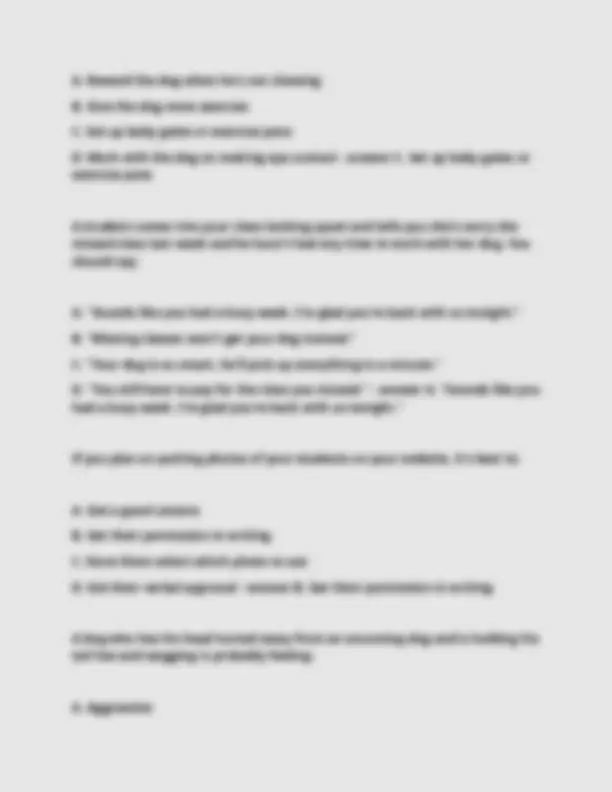



Study with the several resources on Docsity

Earn points by helping other students or get them with a premium plan


Prepare for your exams
Study with the several resources on Docsity

Earn points to download
Earn points by helping other students or get them with a premium plan
Community
Ask the community for help and clear up your study doubts
Discover the best universities in your country according to Docsity users
Free resources
Download our free guides on studying techniques, anxiety management strategies, and thesis advice from Docsity tutors
Yellow belt - Six Sigma questions and answers
Typology: Exams
1 / 32

This page cannot be seen from the preview
Don't miss anything!

























Clapping your hands excitedly to get your dog to come is: A. Prompting B. Capturing C. Fading the Lure D. Primary Reinforcer - answer A. Prompting According to the Humane Hierarchy, environmental factors are: A. Between positive reinforcement and negative punishment B. Directly above negative reinforcement C. Above classical conditioning D. At the bottom of the hierarchy - answer C. Above classical conditioning A client just got a puppy and after the first week you ask her, "How is everything going?" She says, "It's great!" and doesn't say anything else. What should you say next? A. "That's terrific! So now lets start working on sit." B. "Wonderful! So what's going on with house training?" C. "You just got a puppy... I doubt everything's great." D. "Excellent! Let's pick up where we left off last week." - answer B. "Wonderful! So what's going on with house training?"
Belyayev found that his domesticated foxes: A. Developed curly tails and floppy ears B. Were still afraid of humans C. Bore many resemblances to gray wolves D. Developed longer legs and narrow chests - answer A. Developed curly tails and floppy ears Empathetic listening is all of the following except: A. Listening with focus. B. "Reading" between the lines C. A great way to build relationships with clients. D. A skill to use only when dealing with difficult clients. - answer D. A skill to use only when dealing with difficult clients. Whenever Brian has the TV on a high volume, Lucky howls until Brian turns it down. This is: A. Positive reinforcement. B. Negative reinforcement. C. Positive punishment. D. Negative punishment - answer B. Negative reinforcement.
A. Without criteria. B. A neutral stimulus. C. Not learned. D. An emotional response. - answer C. Not learned Social Media: A. Is something to avoid as a trainer. B. Is great for networking as long as you're careful about what you say. C. Should be used only when addressing controversial issues. D. Is your own personal business and nothing to do with training. - answer B. Is great for networking as long as you're careful about what you say. Shaking off, lip licking, and yawning are considered: A. Counter-conditioning B. Confrontational. C. Distance-decreasing behaviors. D. Calming signals - answer D. Calming signals. A dog knows the hand gesture for stay. Now you want to teach him the verbal cue. You should: A. Use the verbal "stay" followed by the hand gesture. B. Use the hand gesture followed by the verbal "stay." C. Use the verbal "stay" and if no response, add the hand gesture.
D. Use the hand gesture and if no response, add the verbal "stay." - answer A. Use the verbal "stay" followed by the hand gesture. It's important for clients in your group class to: A. Get their dogs to master a behavior before leaving class. B. Stay at the same level as other students in the class. C. Learn to deal with all distractions. D. Practice as often as possible in their home - answer D. Practice as often as possible in their home A client says to you, "How much longer do I have to keep giving my dog treats?" You should say: A. "As long as I tell you to." B. "As long as you want a well-trained dog." C. "Probably just another few weeks." D. "Your dog is doing so well, and the treats keep him motivated." - answer D. "Your dog is doing so well, and the treats keep him motivated." Eva is afraid Ziggy will unintentionally knock down her one-year-old nephew. So when the nephew comes to visit, Eva puts Ziggy in his crate with a peanut butter-filled Kong. This is: A. Positive reinforcement B. Management C. Classical conditioning
A. Violate the CCPDT Code of Ethics B. Tend to make dogs fearful C. Have shown a high success rate D. Are necessary with under socialized dogs. - answer B. Tend to make dogs fearful All of the following are true about flat collars except: A. They come with three types of buckles B. You should be able to fit a finger between the dog's neck and the collar C. Reactive dogs may come out of them easily D. They are not recommended for dogs who are hard pullers - answer B. You should be able to fit a finger between the dog's neck and the collar This disease affects a dog's central nervous system and if often fatal: A. Hepatitis B. Distemper C. Rabies D. Parvo - answer C. Rabies All the following are examples of environmental management except: A. A tether B. Keeping items you don't want chewed in a closet
C. A baby gate D. Asking a dog to wait before going out the front door - answer D. Asking a dog to wait before going out the front door Whenever Scarlet whimpers, Cathy runs over to the dog, asking, "What's wrong?" This is: A. Positive reinforcement B. Negative reinforcement C. Positive punishment D. Negative punishment - answer A. Positive reinforcement Which type differential reinforcement gives you the most options for rewarding a behavior: A. DRA B. DRI C. DRO D. DRE - answer C. DRO All of the following the examples of classically conditioned stimuli expect: A. Owner's keys in the door B. Drinking from a water bowl when thirsty C. Clicker
CCPDT allows all of the following except: A. Prong collars B. Electric shock collars C. Helicoptering D. Positive punishment - answer C. Helicoptering On his morning walk, a dog lunges at a skateboarder, then tried to catch a squirrel and then barks and jumped on a child who has rushed over to meet him, grabbing the child's coat and tearing it. This could be considered: A. Premack Principle B. Environmental management C. Negative reinforcement D. Trigger stacking - answer D. Trigger stacking Whenever Rio pulls on walks, Steve gently jerks the leash to stop the pulling, saying, "I'm not hurting him!" This is: A. Positive reinforcement B. Negative reinforcement C. Positive punishment D. Negative punishment - answer C. Positive punishment Using a verbal marking when a dog has correctly performed a behavior is considered a:
A. Primary reinforcer B. Secondary reinforcer C. High value reinforcer D. Fixed reinforcer - answer B. Secondary reinforcer A client tells you, "I don't know why I'm bothering to try to train my dog. It isn't working at all so far." You should: A. Point out how much progress the dog has made B. Tell the client their negativity is rubbing off on the dog C. Tell the client this is a long, slow process and he has to work at the dog's pace D. Suggest they go see another trainer - answer A. Point out how much progress the dog has made Disruptions during group classes: A. Can be valuable learning experiences B. Are to be avoided at all costs C. Are traumatizing to an anxious dog D. Fluster even the most experienced trainers - answer A. Can be valuable learning experiences The best way to figure out a dog's emotional state is:
D. "You should ration how much water you're giving him." - answer B. "When was the last time you took him to the vet." Stormy loves playing in the parking and jumps around in the car when they arrive. Cindy waits until Stormy is sitting calmly, then she opens the door and lets him run. This is: A. Positive reinforcement, followed by negative punishment B. Positive reinforcement, followed by positive punishment C. Negative reinforcement, followed by positive reinforcement D. Negative punishment, followed by positive reinforcement - answer D. Negative punishment, followed by positive reinforcement Dogs will repeat a behavior if there's a desirable consequences. This is: A. Thorndike's Law of Effect B. Skinner's conditioning chamber C. A -> B -> C D. Premack Principle - answer A. Thorndike's Law of Effect An example of empathetic listening is: A. Client: "My dog's dumb." You: "You sound frustrated." B. Client: "My dog's dumb." You: "I couldn't agree more." C. Client: "My dog's dumb." You: "You shouldn't say things like that." D. Client: "My dog's dumb." You: "There are no dumb dogs -- just dumb people." - answer A. Client: "My dog's dumb." You: "You sound frustrated.:
A dog is standing and looking at his handler, who's telling you, "I don't want to give him treats anymore because he never sits when I tell him to!" You should say: A. "That makes sense." B. "He's giving you great eye contact right now. Go ahead and treat him for that." C. "How are you asking for sit?" D. "You have to use treats or he won't sit." - answer B. "He's giving you great eye contact right now. Go ahead and treat him for that." All of the following statements are correct except: A. Dogs' relationships with each other are fluid B. Dogs are not considered pack animals C. Dogs communicate mostly with their bodies D. Dogs are considered pack animals - answer D. Dogs are considered pack animals Soft crates: A. Are tough to chew through B. Are also known as "airline" crates C. Are good for temporary use or travel D. Provide the most ventilation - answer C. Are good for temporary use or travel
Post-reinforcement pause usually occurs with: A. Fixed interval reinforcement B. Fixed ratio reinforcement C. Variable interval reinforcement D. Variable ratio reinforcement - answer B. Fixed ratio reinforcement All of the following may signal extreme distress in a dog except: A. Low, wagging tail B. Sweaty paws C. High, wagging tail D. Heavy shedding - answer A. Low, wagging tail When a dog wears a harness with the leash clipped to his back: A. He typically requires DS/CC B. He may display opposition reflex C. He can easily come out of it is reactive D. It's best for dogs with a head circumference smaller than their neck - answer B. He may display opposition reflex When designing your plan for a one-hour class: A. Assume at least 15 minutes will spent on the dogs socializing
B. Considering it lose outline and just see how the class goes C. Build in time for potty breaks D. Stick to the plan regardless of what happens - answer C. Build in time for potty breaks A client shows up with a dog in a prong collar, telling you, "This is what my vet recommended." You should say: A. "Did you know vets aren't trained in behavior?" B. "I won't work with you unless you remove that." C. "I have some alternative you may find even more effective." D. "But it's not what I recommend." - answer C. "I have some alternatives you may find even more effective." According to the Humane Hierarchy: A. Positive punishment is never to be used B. Negative punishment and positive punishment are on the bottom tier C. Positive punishment is a form of classical conditioning D. Positive punishment should be used only as a last resort - answer D. Positive punishment should only be used as a last resort If a person says "sit" when the dog already knows the nonverbal cue, the dog is likely to: A. Consider the verbal cue more salient B. Block the verbal cue
D. There can be enough space between the dogs - answer D. There can be enough space between the dogs Once you get your CPDT-KA certification: A. You never have to learn anything else about dogs B. You'll want to look into webinars and other training related resources C. You should start learning a new dog-related skill D. You never need to check the CCPDT website - answer B. You'll want to look into webinars and other training related resources The biggest challenge of an outdoor class is: A. Wild animals B. Cars C. Weather D. Dogs walking by - answer C. Weather When a dog is at ease, his ears will be: A. Neither forward nor pulled back B. Forward C. Pulled back D. Folded over - answer A. Neither forward nor pulled back
If you can't clean your training facility with an antimicrobial solution, your next best bet is: A. Soap and water B. Scrub brush C. Laundry detergent D. Bleach and water - answer D. Bleach and water A dog refuses to walk down a particular street in hi neighborhood because when he was a puppy, a big dog came running over to him and pinned him. It would be best to train this dog by using: A. Premack principle B. DS/CC C. Learned irrelevance D. DRO - answer B. DS/CC A dog pushes his treat ball around the house with his nose, causing bits of kibble to fall out of a large hole at one end of the ball. This is: A. Operant conditioning B. Classical conditioning C. Counter conditioning D. Generalization - answer D. Generalization Asking a dog to touch his nose to your hand is: